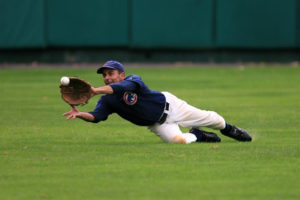
The Twilight League
Part III
See part one here.
See part two here.
With thanks to Roland DePew and Mike Freda-
The Twilight League played at Painter Park until about 1990, sending fly balls into Kelsey Avenue and the neighboring properties; finally, they moved to Allingtown, playing their games at Quigley Stadium, so named for local businessman Moe Quigley, who originally built the stadium. In the words of longtime player and league officer Mike Freda:
“There was one significant development that triggered the complete move to Quigley Stadium from Painter Park, and that was aluminum bats becoming more technologically enhanced and, as players were also naturally getter bigger, more balls were flying out of Painter at a record pace.
“Right field was only 265 feet down the line, and the right field bank stretching into right centerfield was relatively short in distance. Many of us right hand hitters were hitting homers to right field with wood bats in the late 1970’s before the first phase of aluminum bats entered the league around 1979. Those aluminum bats paled in comparison to the more sophisticated aluminum bats in the 1990’s.
“Also, it had become apparent that Quigley was the more “glamorous” venue with its major league dimensions and stadium seating style.
“More top players around the area were drawn to the league because of Quigley. It also was a better venue to host tournaments with leagues from all over Connecticut and New York, which contributed greatly to the league’s revenue. As for me, I had become very comfortable in climbing up the embankments at Painter Park to chase long fly balls but I liked the room in the outfield to run down balls at Quigley Stadium with center field being 410 feet from home plate.”
It is interesting to note that the Twilight League returned to the use of wooden bats in 2004.
Today, Twilight League players come from 36 towns, and represent Connecticut, New Hampshire, Pennsylvania and even Puerto Rico. In addition, they represent forty colleges. The league operates with six teams who each play 25 games per season. They play from Monday to Saturday, beginning in Mid-May and playing until Mid-July. Everything is very organized and competitive, and collegiate umpires call the games.
Among the players are veteran players, many of whom are active up into middle-age; in addition, there are a great many players in their teens and twenties. There is a special chemistry at work there: the veteran players offer guidance and the younger players work to improve their skills—in this way they feed off of each other.
For more details, see their website www.whtl.org